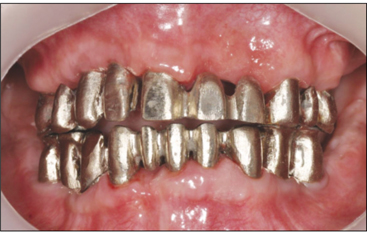J Korean Acad Prosthodont.
2012 Oct;50(4):330-335. 10.4047/jkap.2012.50.4.330.
Full mouth rehabilitation of an oligodontia patient with intellectual disability based on shortened dental arch concept: a case report
- Affiliations
-
- 1Department of Prosthodontics, School of Dentistry, Seoul National University, Seoul, Korea. young21c@snu.ac.kr
- KMID: 2195477
- DOI: http://doi.org/10.4047/jkap.2012.50.4.330
Abstract
- Shortened dental arch (SDA) as a treatment goal is the concept that stable occlusion and enough masticatory force can be achieved by restoration to the second premolars when the situation is not favorable. SDA could be applied both natural teeth and implant supported fixed prostheses. This case dealt with a patient who has grade 2 intellectual disability and a lot of missing teeth. Because of intellectual disability, patient cooperation during treatment could not be expected. Therefore every treatment should be done under general anesthesia. In addition to that, ridge resorption around molar area was severe and there were maxillary sinus pneumatization and maxillary sinusitis which increased failure probability. SDA concept was adopted to reduce risk factor and minimize general anesthesia. After the treatment, functional and esthetic improvement was achieved and oral hygiene was fortified by periodic recall check and education.
MeSH Terms
Figure
Cited by 1 articles
-
Full mouth rehabilitation of edentulous patient with intellectual disability using implants and monolithic zirconia
Ki-Won Jeong, Sung-Hun Kim, Jung-Suk Han, In-Sung Yeo, Hyung-In Yoon
J Korean Acad Prosthodont. 2017;55(2):156-163. doi: 10.4047/jkap.2017.55.2.156.
Reference
-
1. Kanno T, Carlsson GE. A review of the shortened dental arch concept focusing on the work by the Käyser/Nijmegen group. J Oral Rehabil. 2006. 33:850–862.
Article2. Witter DJ, De Haan AF, Käyser AF, Van Rossum GM. A 6-year follow-up study of oral function in shortened dental arches. Part II: Craniomandibular dysfunction and oral comfort. J Oral Rehabil. 1994. 21:353–366.
Article3. Witter DJ, de Haan AF, Käyser AF, van Rossum GM. A 6-year follow-up study of oral function in shortened dental arches. Part I: Occlusal stability. J Oral Rehabil. 1994. 21:113–125.
Article4. Solow RA. Comprehensive implant restoration and the shortened dental arch. Gen Dent. 2010. 58:390–399.5. Armellini D, von Fraunhofer JA. The shortened dental arch: a review of the literature. J Prosthet Dent. 2004. 92:531–535.
Article
- Full Text Links
- Actions
-
Cited
- CITED
-
- Close
- Share
- Similar articles
-
- Oral rehabilitation for a patient with oligodontia and maxillary hypoplasia
- Full mouth rehabilitation of edentulous patient with intellectual disability using implants and monolithic zirconia
- Full mouth rehabilitation of the intellectually disabled patient with collapsed bite using partial removable dental prosthesis: a case report
- Mandibular full arch rehabilitation of a patient with severely worn dentition after completion of maxillary full arch rehabilitation
- Using implants for worn dentition with the altered vertical dimension of occlusion based on shortened dental arch concept: a case report
















